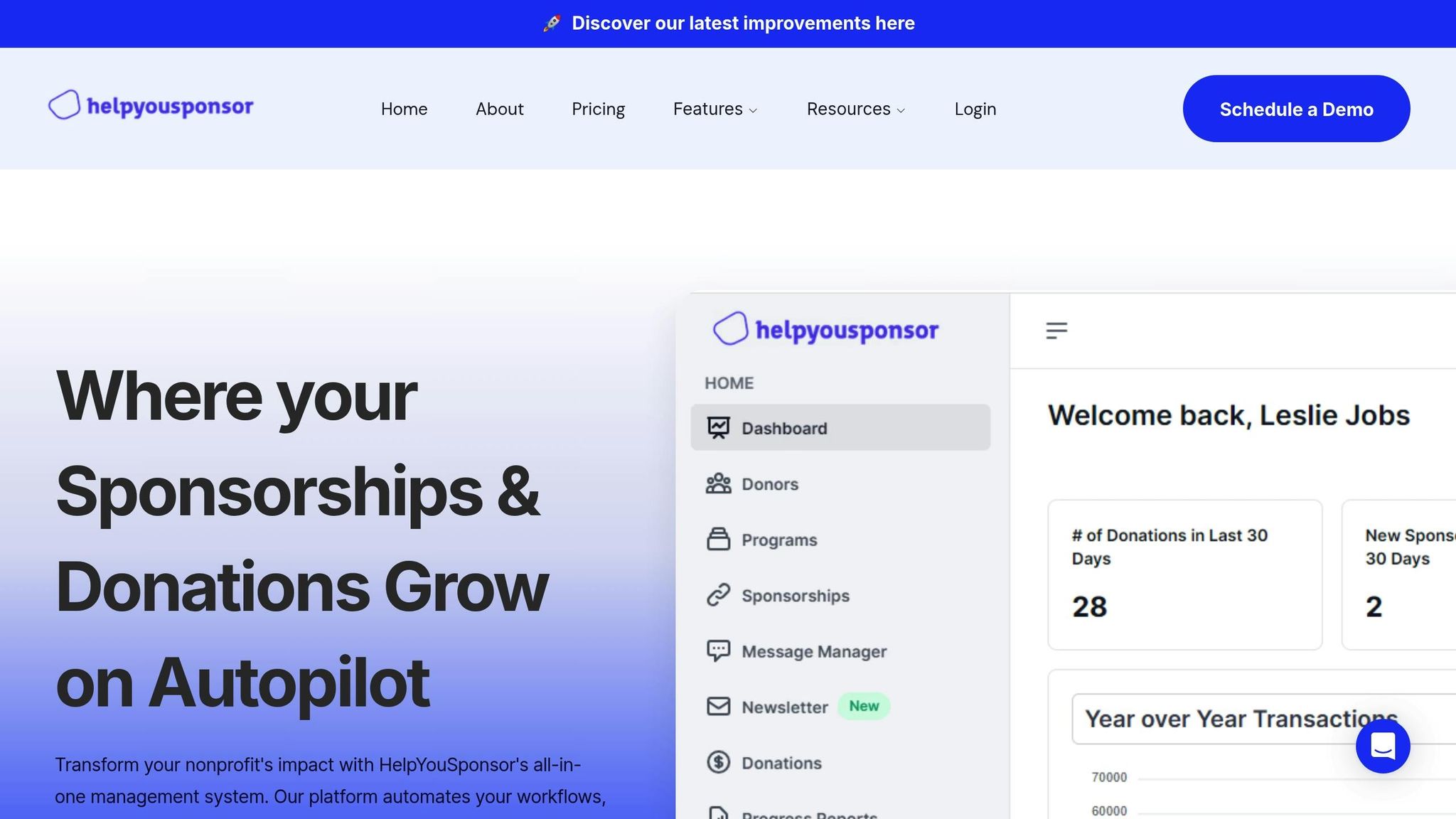Storytelling vs. Data: What Drives Donor Action?
Explore how combining emotional storytelling with data can enhance donor engagement and inspire action in nonprofit fundraising.

What’s the best way to inspire donors: emotional stories or hard data? Both storytelling and data have their strengths, but the most effective nonprofit strategies combine them.
- Storytelling builds emotional connections, making donors feel personally invested in the cause. A single story about a child’s success can inspire action far more than broad statistics.
- Data provides measurable proof of impact, giving donors confidence that their contributions are making a difference. Metrics like donation trends and program outcomes reinforce trust.
- Together, they create a balanced approach: stories engage the heart, while data appeals to logic. For example, sharing a personal success story alongside statistics about overall program success can boost donations by up to 50%.
The key is knowing your audience. Emotional donors might respond to heartfelt narratives, while analytical donors need clear, transparent metrics. Tools like HelpYouSponsor make it easier to blend these approaches by providing real-time updates, personalized stories, and detailed analytics.
Bottom line: Use stories to connect, data to convince, and both to inspire action.
How Storytelling Engages Donors
What is Storytelling in Fundraising?
Storytelling in fundraising isn’t just about explaining what your nonprofit does - it’s about turning your mission into something personal and relatable. It’s a way to humanize causes, making them feel real and immediate to donors.
When done right, storytelling combines facts with emotions. Instead of bombarding donors with numbers, it allows them to connect with the individuals behind those statistics. This shift transforms abstract issues into personal experiences, helping donors feel more invested.
Studies show that storytelling activates parts of the brain that improve message retention and deepen emotional connections. By blending data with human emotion, nonprofits can craft narratives that inspire action.
Key Elements of Good Storytelling
The most effective fundraising stories share a few essential ingredients that motivate donors to act:
- Honesty: Donors can tell when a story is genuine. Authenticity builds trust, while exaggeration or fabrication can do the opposite. Real stories of challenges and triumphs resonate the most.
- Relatability: When stories reflect shared experiences or common struggles, donors can see themselves in the narrative, making the cause feel closer to home.
- Emotional Appeal: A strong story stirs emotions by focusing on the human impact of support. This connection helps donors see how their contributions make a real difference.
- Clarity: A well-structured story - one with a clear beginning, middle, and end - makes it easier for donors to follow and understand the journey from challenge to resolution.
- Strength-Based Messaging: Highlighting the resilience, talents, and aspirations of those you serve shows respect and dignity, encouraging deeper donor commitment.
These elements form the foundation of compelling storytelling that drives meaningful donor engagement.
Benefits of Storytelling for Nonprofits
When nonprofits use storytelling effectively, they see real benefits in how donors connect and contribute:
- Stronger Donor Retention: Stories leave a lasting emotional impact. When donors remember the specific person or community their support helped, they’re more likely to stay involved.
- Increased Engagement and Generosity: Emotional narratives don’t just deepen connections - they also encourage donors to give more generously by clearly showing the impact of their contributions.
Research backs this up. People are more likely to donate when they see the story of one identifiable person rather than just hearing broad statistics.
Storytelling also simplifies complex issues, making them more relatable and easier to understand. This helps nonprofits reach a wider audience and communicate their mission more effectively, ensuring donors feel informed and inspired to act.
Data-Driven Methods for Donor Engagement
Understanding Data-Driven Fundraising
Data-driven fundraising uses measurable data and analytics to help nonprofits make informed decisions and showcase their impact to donors. While emotional storytelling remains a key part of fundraising, this approach focuses on numbers and proven strategies to optimize campaigns and build trust.
By analyzing data like donation trends, donor behavior, and program outcomes, nonprofits can identify what’s working, what isn’t, and where resources should go to achieve the best results. This replaces guesswork with actionable insights, making fundraising efforts more targeted and effective.
For example, looking at giving patterns and donor demographics allows organizations to segment their audience and create personalized outreach strategies. This not only boosts the chances of a successful campaign but also builds credibility. When donors see transparent, data-backed results, they’re more likely to trust that their contributions are making a real difference.
Key Metrics Nonprofits Should Track
To make the most of data-driven fundraising, nonprofits need to focus on specific metrics that measure their performance and impact:
- Donor Retention Rate: Tracks how many donors continue to give over time, offering insights into long-term sustainability.
- Donor Lifetime Value (LTV): Estimates the total amount a donor might contribute throughout their relationship with the organization, helping prioritize stewardship efforts.
- Cost per Dollar Raised: Shows how efficiently funds are raised by comparing fundraising costs to the amount brought in. While lower costs are ideal, this figure can vary depending on the size of the organization and its methods.
- Program Expense Ratio: Highlights the percentage of spending that goes directly to mission-related programs versus administrative costs. Donors often favor organizations that allocate more resources to their core mission.
- Campaign Performance Metrics: Includes stats like email open rates, online donation conversions, and direct mail response rates. These help nonprofits fine-tune campaigns and choose the most effective communication methods.
- Impact Metrics: Measures tangible results, such as the number of people helped or meals provided, giving donors clear evidence of how their contributions are making a difference.
Benefits of Using Data in Fundraising
Data doesn’t just improve decision-making - it also enhances donor relationships and operational efficiency. Sharing clear metrics with donors builds transparency and trust, while data insights help nonprofits target the right donor segments and choose communication methods that resonate.
Looking at historical trends can also help nonprofits plan for the future. By forecasting revenue and identifying potential challenges early, they can confidently design programs and allocate resources. Regularly tracking and analyzing data ensures accountability and keeps organizations on track toward their goals.
Visual tools like charts, graphs, and infographics make it easier for donors to grasp the impact of their contributions. These tools also strengthen grant applications and help engage major donors by presenting clear, evidence-based results. In short, data-driven strategies provide nonprofits with the clarity and tools needed to make a lasting impact.
Combining Storytelling and Data for Better Results
Why Combining Storytelling and Data Works
Nonprofits see the best donor engagement when they mix emotional storytelling with solid data. This blend, often called data storytelling, goes beyond just throwing out numbers. It creates narratives that connect emotionally while being backed by credible evidence.
Why does this work so well? Because pairing facts with emotion builds trust. Stories make the data relatable, while the data adds weight and context to the story. In fact, people are 22 times more likely to remember facts when they’re tied to a story. This means your impact stats stick better when they’re part of a meaningful narrative.
The outcomes are impressive. Story-driven fundraising campaigns see a 50% boost in donations compared to campaigns focused only on data. Even better, donation pages featuring a story lead to a 20% increase in the average gift size. By linking data with human experiences, you turn dry numbers into something donors can connect with on a personal level.
The evidence is clear - now it’s about using this approach effectively.
How to Integrate Storytelling and Data
To make the most of storytelling and data, start by collecting real-life stories from the people your organization serves. At the same time, track the metrics that show your broader impact. Together, these elements create narratives that highlight both individual stories and the big-picture success of your work.
Here’s how it can look: Begin with a personal story - a veteran who found stable housing through your program, for example. Then follow up with data that shows the larger impact, like how 85% of participants in your program maintain stable housing after two years. This method ties an emotional connection to a proven track record, making your case even stronger.
Visuals can also enhance your message. Use charts, graphs, and infographics alongside photos and quotes to make the data feel more personal. When donors can see the faces behind the numbers, the statistics become much more meaningful.
Timing plays a big role too. Nonprofits that regularly review and tweak their storytelling strategies see a 34% improvement in donor retention. This means it’s worth analyzing which story-data combinations resonate most with your audience and refining your approach based on what works.
The key is balance. Your stories should naturally lead donors to want to learn more about your overall impact, while your data should reinforce the emotional connection your story creates. When these elements work together, they amplify your message, strengthen donor relationships, and ultimately drive better results. Done right, this approach doesn’t just inform - it inspires action.
Storytelling vs. Data: A Direct Comparison
Strengths and Weaknesses of Each Method
Storytelling is a powerful way to spark an emotional connection with donors. For example, sharing a story like Sarah's - a single mom who turned her life around with the help of job training - can make an abstract cause feel deeply personal. Stories make issues relatable and leave a lasting impression, often staying with donors long after they've forgotten numbers or charts.
But storytelling comes with its own set of challenges. A single story can't fully represent the overall impact of an initiative, and some donors might question whether one success story is truly reflective of broader outcomes. Plus, gathering authentic stories takes time, and without supporting data, these narratives can feel anecdotal rather than substantive.
On the other hand, data-driven approaches build trust by offering measurable, concrete results. When you share statistics that clearly demonstrate your program's effectiveness, you provide donors with evidence they can rely on. This approach resonates with analytical donors who want tangible proof before making decisions. It’s also particularly valuable for grant applications or major donor presentations, where accountability is often a top priority.
However, data alone rarely stirs emotions. For instance, knowing that a food bank serves hundreds of families each month is important, but it doesn’t evoke the same urgency as hearing about a single parent struggling to feed their kids. Numbers can feel detached and impersonal, making it harder for donors to connect on a human level.
Different people respond to different approaches. Some are drawn to heartfelt stories, while others need solid metrics to feel confident in their decision to give. Finding a balance between these methods is crucial for engaging a broad audience of donors effectively.
Comparison Table: Storytelling vs. Data-Driven Methods
| Aspect | Storytelling | Data-Driven Methods |
|---|---|---|
| Emotional Impact | High – Builds personal connections | Low – Appeals to logic |
| Credibility | Medium – Can feel anecdotal | High – Provides measurable proof |
| Transparency | Low – Focuses on individual cases | High – Reflects organizational effectiveness |
| Donor Retention | High – Memorable stories foster relationships | Medium – Relies on consistent results |
| Scalability | Low – Time-intensive to gather | High – Systematic and efficient |
| Best Use Cases | Individual donor appeals, social media | Grant applications, major donor meetings |
| Resource Requirements | High – Requires significant staff time | Moderate – Investment in tracking systems |
| Measurement Difficulty | Hard – Attribution is challenging | Easy – Metrics are trackable |
This side-by-side comparison highlights the strengths and weaknesses of each approach, setting the stage for how they can be combined for maximum impact.
1- Power of Data Storytelling For Fundraising
Using HelpYouSponsor for Better Donor Engagement

HelpYouSponsor brings together the power of storytelling and data to inspire donor action. By blending personal narratives with clear, measurable outcomes, the platform ensures donors connect both emotionally and logically. Let’s dive into how HelpYouSponsor achieves this balance through its features.
How HelpYouSponsor Supports Storytelling
Building strong donor relationships starts with personalized communication. HelpYouSponsor’s 24/7 sponsor-recipient channel serves as a direct line between donors and the individuals they support, offering real-time updates that keep donors engaged and invested.
The platform also features an automated email system that personalizes updates using short codes. Instead of generic messages, donors receive tailored updates about their recipient’s journey - whether it’s a recent milestone or a current need. These updates transform routine communications into meaningful, ongoing stories.
Additionally, website integration showcases recipient profiles with photos and personal stories. This feature allows potential donors to connect with individual cases that resonate with them on a personal level, often before they’ve even made their first contribution.
How HelpYouSponsor Improves Data-Driven Strategies
While storytelling tugs at the heart, data builds trust. For donors who value transparency, HelpYouSponsor offers real-time donation tracking. Every contribution is recorded and categorized, creating a clear audit trail that shows exactly how funds are allocated across programs and initiatives.
The platform’s advanced reporting tools provide detailed analytics on donation trends, campaign performance, and recipient outcomes. These reports can be customized to meet the needs of different donor groups. For instance, major donors might prefer quarterly summaries with financial breakdowns, while grant foundations may require annual reports featuring demographic data and success rates.
Integrated payment gateways further simplify the process by ensuring accurate financial records and real-time insights into fundraising performance. This automation frees up your team to focus on analyzing trends and refining strategies instead of juggling administrative tasks.
Combining Storytelling and Data with HelpYouSponsor
HelpYouSponsor seamlessly merges storytelling with data, ensuring your messages resonate with every type of donor. The platform allows you to collect updates from recipients via its communication channel and combine these personal stories with measurable outcomes. This way, you can highlight both individual progress and overall program success.
You can also segment donors based on their giving history to deliver tailored content. Analytical donors might appreciate detailed monthly reports that pair statistics with recipient stories, while relationship-oriented donors could receive more frequent updates with personal narratives supported by relevant data. This strategic blend ensures that every donor feels valued and connected.
Conclusion: Choosing the Right Method for Your Nonprofit
Balancing Storytelling and Data
Storytelling drives immediate emotional responses, while data establishes trust over time. Personal stories resonate with donors who act from the heart, while clear metrics appeal to those who prioritize transparency and accountability.
Focusing on just one approach risks missing a key part of donor motivation. The most effective nonprofits find ways to connect with both emotional and analytical donors, leveraging the strengths of each method.
Bringing Both Approaches Together
When storytelling and data are combined, they create a more engaging and well-rounded donor experience. Personal stories draw people in, while factual data reinforces their decision to support your cause.
It’s important to understand how your donors prefer to communicate. Use storytelling to captivate new supporters, then follow up with impact-driven data to deepen their trust. For longtime donors, alternating between heartfelt updates and measurable progress reports can keep both emotional and analytical connections strong.
Tools like HelpYouSponsor can simplify this process by personalizing communications and tracking outcomes. By blending emotional stories with clear data, nonprofits can build stronger relationships with donors, encourage ongoing support, and make a greater impact over time. The key is mastering the art of weaving these two approaches together to inspire action and foster lasting loyalty.
FAQs
How can nonprofits find the right mix of storytelling and data to inspire donors?
Nonprofits can effectively connect with their audience by weaving emotional stories together with solid, evidence-based data. Stories draw people in on a personal level, creating an emotional bond, while data adds weight, showing real-world impact and building trust. When combined, these two elements can make a powerful case for support.
To keep this balance on point, nonprofits should pay attention to donor feedback and track engagement metrics regularly. This ensures that their stories continue to strike an emotional chord and that their data stays relevant and persuasive. By mastering this mix, organizations can not only earn trust but also inspire action and deepen their relationships with supporters.
How can nonprofits effectively combine storytelling and data to engage donors?
Nonprofits can create a powerful connection with their audience by combining storytelling with data. Start by digging into donor data to uncover trends or moments that stand out. These insights can help shape narratives that not only evoke emotion but also showcase the real-world impact of donations.
To make these stories even more compelling, incorporate visuals like charts, graphs, or videos. These tools can help present data in a way that's easy to understand and visually engaging. Tailor the stories to different donor groups for a more personal touch, ensuring they feel relevant and meaningful. And don’t forget to track how well your campaigns perform - this feedback can help you fine-tune your approach over time. By merging the emotional pull of storytelling with the trustworthiness of data, nonprofits can inspire action and nurture long-term donor relationships.
What role do storytelling and data play in increasing donor retention and donation amounts in nonprofit fundraising?
Storytelling holds incredible potential for nonprofits, creating meaningful emotional ties with donors. Campaigns that weave in engaging stories often achieve better donor retention and receive more substantial contributions. Research even shows that nonprofits using storytelling can see donor retention jump by as much as 67% and bring in far more funds than those relying only on raw data.
But here’s where it gets even better: pairing stories with data makes the impact even stronger. Including relevant statistics or measurable outcomes alongside a compelling narrative boosts credibility and builds trust. This combination of heartfelt emotion and concrete evidence not only inspires generosity but also encourages long-term donor commitment and larger contributions over time.

